Invalid leads clogging your pipeline? Stop wasting time on fake prospects.
Lead verification separates genuine opportunities from junk data, protecting your marketing investment.
This guide covers what lead verification is, why it matters, and explores the top tools for 2024 to skyrocket sales productivity. Get ready to supercharge with high-quality, validated leads that actually convert.
Read on!
What is a lead verification tool and how does it work?
A lead verification tool is a piece of software or a service that checks the authenticity and correctness of the information given by potential clients or leads.
Marketing efforts generate leads that are reliable and workable, thanks to this process. This lets sales teams focus on high-quality prospects who are more likely to become paying customers.
How lead verification tools work
Lead verification tools typically operate through a series of steps to validate and qualify leads:
- Data validation:
In this step, you’ll check the lead’s contact information, like their name, phone number, email address, and mailing address. The goal is to make sure the lead can be reached and that the information is correct. Tools like Bouncer can check email addresses against databases of known invalid or disposable email addresses in real-time to make sure they are correct. - Identity verification:
Here, you make sure that the person who sent the form or called is really the person they say they are. You can do this by looking at the lead’s social media profiles or other information that is available to the public to make sure that the information is consistent across all platforms. In some situations, stricter methods may be used, such as asking for a government-issued ID or a credit check. - Qualification assessment:
Finally, you find out how interested and able to buy the potential client is. To get a better idea of the client’s needs and budget, you might need to ask more questions or do a short interview. This helps make sure that sales teams don’t waste time on leads that aren’t likely to become customers.
A lot of tools for verifying leads have automation features that make the verification process faster and easier for businesses. You can manage leads and keep track of them throughout the sales process by combining these tools with customer relationship management (CRM) systems.
As an example, tools like Bouncer and Kickbox use APIs to provide real-time verification. With them, you get ongoing lead validation that does not need much human help.
We’ll now show you why it’s indispensable to verify leads.
Why is it important to verify your leads?
Increases ROI
When you validate lead information, you guarantee that your outreach targets genuine prospects interested in your offerings.
You prevent wasted resources on invalid or unqualified leads and boost conversions and revenue. Removing invalid addresses will keep your ROI on the high side.
Clean leads provide accurate data for better sales analytics. Ultimately, focusing marketing and sales efforts on verified, high-quality leads maximizes campaign effectiveness.
Improves email deliverability
Getting your emails to people’s inboxes instead of spam folders is possible by improving deliverability.
Here’s what you can do:
- Authenticate your email domain and set up proper protocols like SPF, DKIM, DMARC, and BIMI
- Maintain a clean, engaged subscriber list by removing inactive or invalid emails
- Send high-quality, relevant content that provides value to your audience
- Warm up your IP address by gradually increasing email volume over time
- Monitor and remove subscribers who mark your emails as spam
- Maintain a good sender reputation by following email marketing best practices
- Use double opt-in to ensure subscribers want your emails
- Segment your list and personalize emails for better engagement
- Monitor blacklists and ensure your IP/domain is not listed
- Test emails for rendering and user experience across devices and clients
- Implement an ideal sending frequency based on your audience’s preferences
Higher deliverability increases email visibility, open rates, and conversions since recipients are more likely to see and engage with messages in their primary inbox.
Authentication, list hygiene, and content optimization all work together to let email providers know that your emails are real and wanted, which keeps them from being blocked or marked as spam. The best way to get the most out of your email marketing is to make sure that you reach your audience.
Boosts conversions
Verify that your sales and marketing efforts are reaching people who are actually interested, and you will get more conversions.
Getting rid of invalid or unqualified leads from your outreach keeps you from wasting time and money on people who are not likely to convert. You can focus your campaigns on high-quality leads who have shown interest and are more likely to do what you want them to do, like buy something, set up a demo, or ask for a consultation.
Verified leads are more interested, which makes it more likely that they will open emails, click through, and eventually become customers.
Protects domain reputation
Lead validation lowers your bounce rate and keeps you from falling for spam traps that can hurt your sender score.
This process maintains compliance with regulations and enhances engagement by targeting legitimate recipients, which, in turn, preserves your brand image and improves deliverability.
Regular verification, employing advanced tools, and adopting double opt-in mechanisms are super important for keeping your list clean. Metric monitoring and segmenting lists further improve email performance. It prevents blacklisting and helps build provider trust.
Ultimately, these practices collectively protect and elevate your domain’s reputation in the digital ecosystem.
Lowers spam score
Using only valid and active email addresses lowers spam scores by cutting down on hard bounces and the chance of hitting spam traps.
Email service providers keep a close eye on engagement metrics like open and click-through rates, and this process improves them. You also improve the sender’s reputation by keeping deliverability rates high.
Eliminating invalid addresses through email verification stops blacklisting and makes sure that anti-spam rules are followed, which protects even more against spam complaints.
As a result, all of these actions lower the spam score, which means that emails will show up higher in the inbox, and the sender will keep their good reputation.
Keeps data clean
You can find and get rid of any wrong or useless lead information by checking lead information like contact details, job titles, and company information.
Later, this will help you maintain high data quality for other activities.
Improving the quality of your leads through this process lets you focus on real prospects, which leads to more effective marketing campaigns and higher conversion rates.
Clean data also makes it easier to analyze and make decisions, so you can make smart choices based on accurate insights you get from your lead data.
Reduces bounces
Lead validation is a must if you want to cut down on email bounces and improve deliverability.
You can reduce the number of emails that bounce back by finding and removing invalid, non-existent, or inactive email addresses from your mailing list. An email sender with a high bounce rate may have emails marked as spam or blocked.
You can clean up your email list before sending campaigns by using lead validation. This greatly lowers bounces, safeguards your sender reputation, and keeps resources from being wasted on emails that can not be delivered.
Also, having a clean email list with real people who are interested in what you have to say increases open rates, click-through rates, and the overall performance of your campaign.
Improves customer experience
Lead verification improves customer experience in several key ways:
- Prevents unsolicited communications that frustrate potential customers. Verified leads have expressed interest in your offerings.
- Ensures accurate contact information for seamless communication without bounces or wrong numbers disrupting the customer journey.
- Enables personalized marketing and tailored experiences through verified customer data and insights, meeting individual needs.
- Facilitates authentic interactions by weeding out fake leads and creating a positive impression during the sales process.
Ultimately, lead validation allows businesses to engage with genuine prospects through the right channels, with relevant messaging and customized experiences that delight customers.
Top tips for lead verification
We wouldn’t be ourselves if we didn’t give you some actionable tips on lead verification:
Verify at the source
One of the most effective ways to ensure high-quality lead data is to verify information at the source, during the lead capture process itself.
You prevent invalid or inaccurate data from ever entering your systems, which saves time and resources downstream. When you integrate real-time verification solutions directly on your website’s lead capture forms and landing pages, you can validate user-submitted information as it is being entered.
You can verify email addresses, phone numbers, physical addresses, and other critical lead details against authoritative data sources.

You can easily add this important verification step to your website with Bouncer’s email verification API. Here’s how it works:
- If a person fills out a form on your landing page, the API checks the data against Bouncer’s huge databases of correct information right away.
- If any of the fields fail verification (for example, an invalid email format), the user is told right away and given the chance to fix the entry before it is sent.
- Only leads that have been fully checked out can fill out the form and get into your marketing and sales systems.
- For better lead profiling, the API returns extra data points like email risk scoring, phone type detection, and geographic location.
Bouncer’s API makes sure that your lead database stays clean and usable from the start by catching bad data at its source. You get better sales productivity, email deliverability, marketing ROI, and the overall customer experience.
Watch out for spam traps

Spam traps are fake or recycled email addresses set up by internet service providers (ISPs) and anti-spam organizations to catch illegitimate email senders.
If you accidentally send emails to these trap addresses, you risk being flagged as a spammer, leading to poor deliverability, damaged sender reputation, and potential blocklisting. There are two main types of spam traps to be aware of:
- Pristine traps are brand-new email addresses created solely to catch spammers scraping the web for email lists. These have never been used for any other purpose.
- Recycled traps are old, expired email addresses that have been repurposed as traps after a period of inactivity. Senders with outdated lists may hit these by mistake.
To avoid the consequences of spam traps, you have to implement strong email list hygiene practices:
- Regularly validate and clean your email lists to remove invalid, toxic, or risky addresses using a service like Bouncer.
- Monitor your lists for signs of spam traps like odd username patterns (e.g. [email protected]) or old, unmaintained domains.
- Suppress any emails that result in hard bounces or complaints to prevent further issues.
- Use confirmed opt-in practices and never purchase or rent third-party email lists, which often contain spam traps.
Staying alert for spam traps and keeping your permission-based email database clean will help you protect your sender reputation, make it easier for emails to get delivered, and make sure they get to the right individuals.
Get a tool that removes duplicates

To get rid of duplicate entries in data sets and keep the integrity of the data, you need a deduplication tool that you can trust.
One such tool that can assist with this process is Bouncer, a powerful email verification and data cleansing solution.
Bouncer is best known for its email verification features, but it also has powerful duplicate removal tools that can be used on a wide range of prospect data types, such as email lists and contact databases.
You can upload your data to its API or web application, and it will automatically find and get rid of any duplicate email addresses. Your lists and databases become clean, accurate, and free from redundant entries.
Additionally, Bouncer supports batch processing, so you can quickly go through large data sets and get rid of duplicates at a large scale. Its API can also be built into your web forms and applications, which lets you verify and remove duplicate data submitted by users in real time. This stops any unnecessary entries from entering your systems.
Integrate your tool with your email marketing tool
A very important best practice for keeping your contact list clean is to connect your lead validation services to your email marketing platform.
By implementing this integration with a reliable solution like Bouncer, you ensure only valid and verified email addresses enter your mailing lists. This improves deliverability rates and protects your sender reputation.

Bouncer offers seamless integration capabilities with popular email marketing platforms such as:
And more!
This integration happens through Bouncer’s API or webhooks, which allows for automated real-time verification of email addresses as leads are captured or before they are added to your mailing lists. With its advanced algorithms and a powerful verification process, Bouncer gets rid of invalid, risky, or disposable email addresses and gives you accurate results.
Once Bouncer is connected to your chosen email marketing tool, it periodically checks your existing email lists and gets rid of any email addresses that are not working. That way, you keep the subscriber database clean and up-to-date.
Additionally, this integration lets you keep an eye on email marketing metrics such as open rates, click-through rates, and bounce rates. Then you can make your lead capture and verification processes work better.
When you connect Bouncer to your email marketing platform, you can be sure that your email campaigns reach the right people. Engagement, conversions, and overall marketing ROI all go up because of this.
In addition, this integration protects your sender reputation, cuts down on wasted resources, and makes your email marketing more effective overall. This is the best way for businesses to use email marketing to get the most out of it.
Involve both sales and marketing teams
A best practice that can greatly improve the success of your lead generation and nurturing efforts is to include both the sales and marketing teams in the lead validation process.
You can make sure that the criteria for a qualified lead are clear and fit the needs of your business by encouraging these two important teams to work together. Through this collaborative approach, everyone can agree on what makes a qualified lead, taking into account things like:
- Industry
- Job role
- Company size
- Specific pain points or challenges
- Psychographics
- Demographics
With this alignment, marketing efforts will be focused on getting the right leads. Sales teams can focus their efforts on reaching out to and nurturing the most promising prospects first.
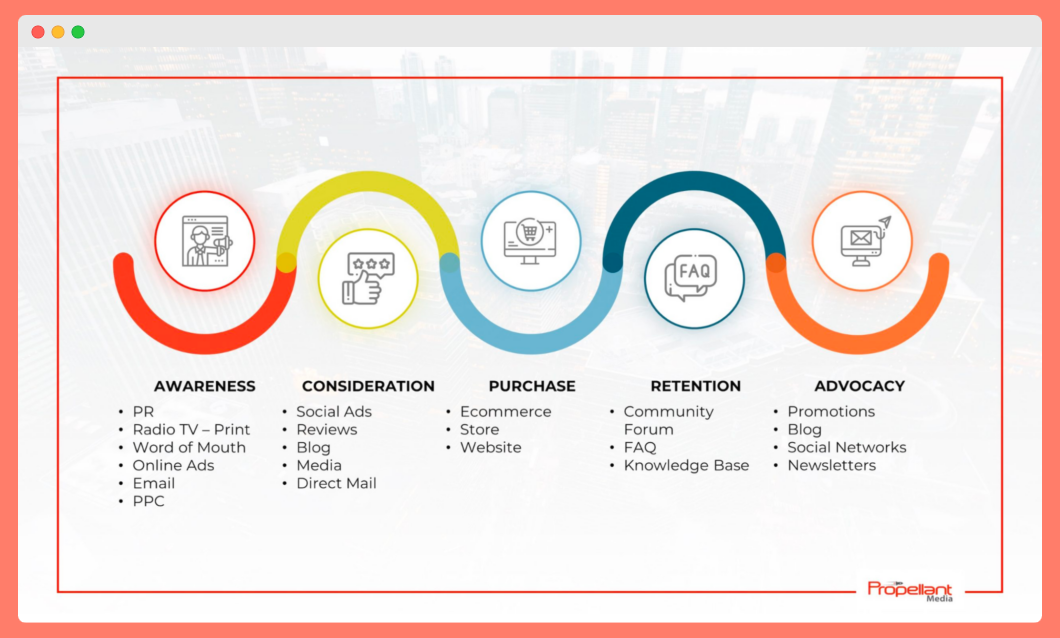
Involving both teams in the process of verifying leads also allows for constant feedback and improvement. Sales teams can give you information on market trends, how customers act, and your company’s sales data. On the other hand, marketing can share data-driven insights about:
- Lead behavior
- Website interactions
- Content consumption patterns
- Email open/click rates
- Engagement
- Social media activity
- Event attendance
- Survey responses
- Sales email reply rates
For better conversion rates, sales teams can switch up how they do things. When sales and marketing work together, they can set clear criteria for qualifying leads. Inbound marketing only sends high-quality, verified, and correctly profiled leads to sales, filtering out the poor quality leads. This streamlined process:
- Improves the efficiency of both teams
- Reduces duplicated efforts
- Optimizes resource allocation
- Enhances the overall customer experience
- Allows for contextual messaging
- Timely follow-ups
- Adds to consistent brand experience
- Helps address specific needs/pain points
Getting the marketing and sales team to work together across departments during the lead verification process can ultimately help you nurture leads better, get more sales, and get a better return on your lead generation efforts.
With all that out of the way, let us take a peek at what tools you should try out in 2024.
Top lead verification tools to try in 2024
Proper lead validation starts with the right tools. Let’s see what we have in store:
#1 Bouncer
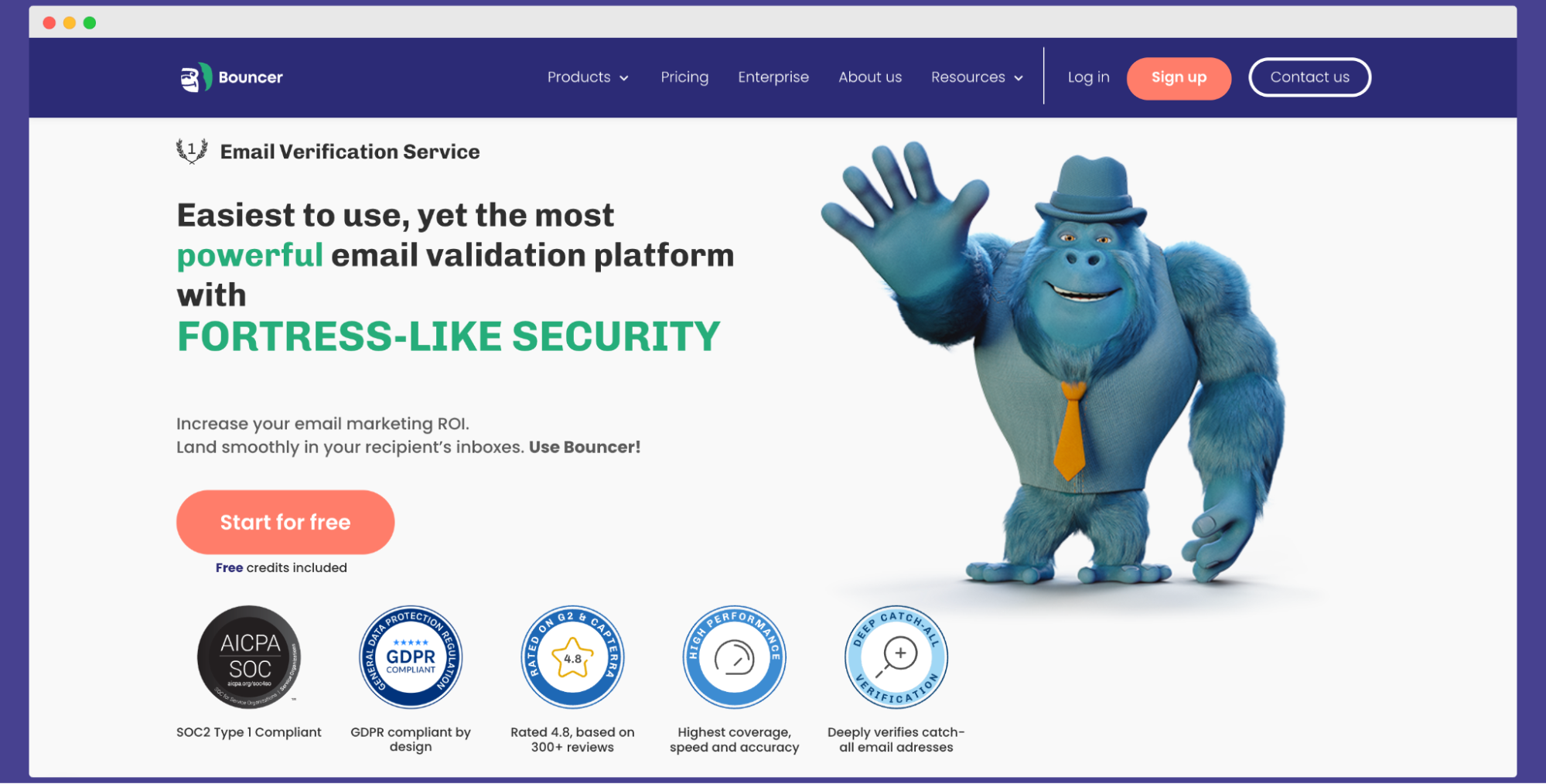
Bouncer is a leading email verification and deliverability solution that stands out as a top choice for businesses seeking to maintain clean and accurate email lists.
Here’s why Bouncer should be on your radar as one of the top lead validation tools to try in 2024:
- You can check email addresses in bulk or in real-time as leads are being captured with Bouncer’s list and API verification tools.
- This program’s complex algorithms and AI-powered verification process make it very accurate, lowering the number of false negatives and correctly classifying email addresses.
- With the ability to check up to 200,000 emails per hour per customer, Bouncer is a powerful tool that can be used by businesses of all sizes.
Here are some of the key Bouncer features:
- Email Checker & Verifier: Check and verify your email list easily by uploading up to 250,000 addresses and finding emails that are safe to send and addresses that will be thrown away. In just a few clicks you can verify huge databases
- Bounce Estimate: Bouncer provides insights on potential bounce rates for your email campaigns.
- Free Email Verification Sampling: Test the quality of your email list without full verification.
- Toxicity Check: Identify and remove toxic email addresses, including those associated with breaches, complainers, litigators, or potential spam traps.
- Email Verification and Validation API: Bouncer’s API enables you to integrate precise email validation capabilities into your IT solutions.
- Deliverability Kit: Test your inbox placement, verify authentication, monitor blacklists, and receive alerts for potential issues.
If you’re still on the fence about Bouncer, here are some reasons why you should give it a go:
- Bouncer’s advanced algorithms and extensive coverage ensure accurate email verification (99.5% accuracy), which minimizes false negatives and unknown results.
- With the ability to verify up to 200,000 emails per hour per customer, Bouncer can handle large-scale email list verification efficiently.
- From email verification and toxicity checks to deliverability insights and API integration, Bouncer offers a comprehensive suite of features for effective email list management.
- Bouncer’s user-friendly interface and seamless integration capabilities make it accessible for businesses of all sizes and technical expertise.
- Bouncer follows SOC 2 and GDPR rules to protect data and privacy, so you can feel safe when working with private data.
- Compared to other more expensive email verification tools, Bouncer provides exceptional value for money. Its pricing plans are pay-as-you-go and super affordable, especially for small and medium-sized businesses, without compromising on quality or features.
- There are plenty of integrations with your favorite CRMs, email marketing tools, data analytics,
When you look at the best lead verification tools for 2024, Bouncer stands out as a clear winner. It has a great mix of accuracy, performance, integrations, features, and ease of use, which makes it a great choice for businesses that want to keep their email lists clean and effective.
Try Bouncer now and get 100 free credits that never expire!
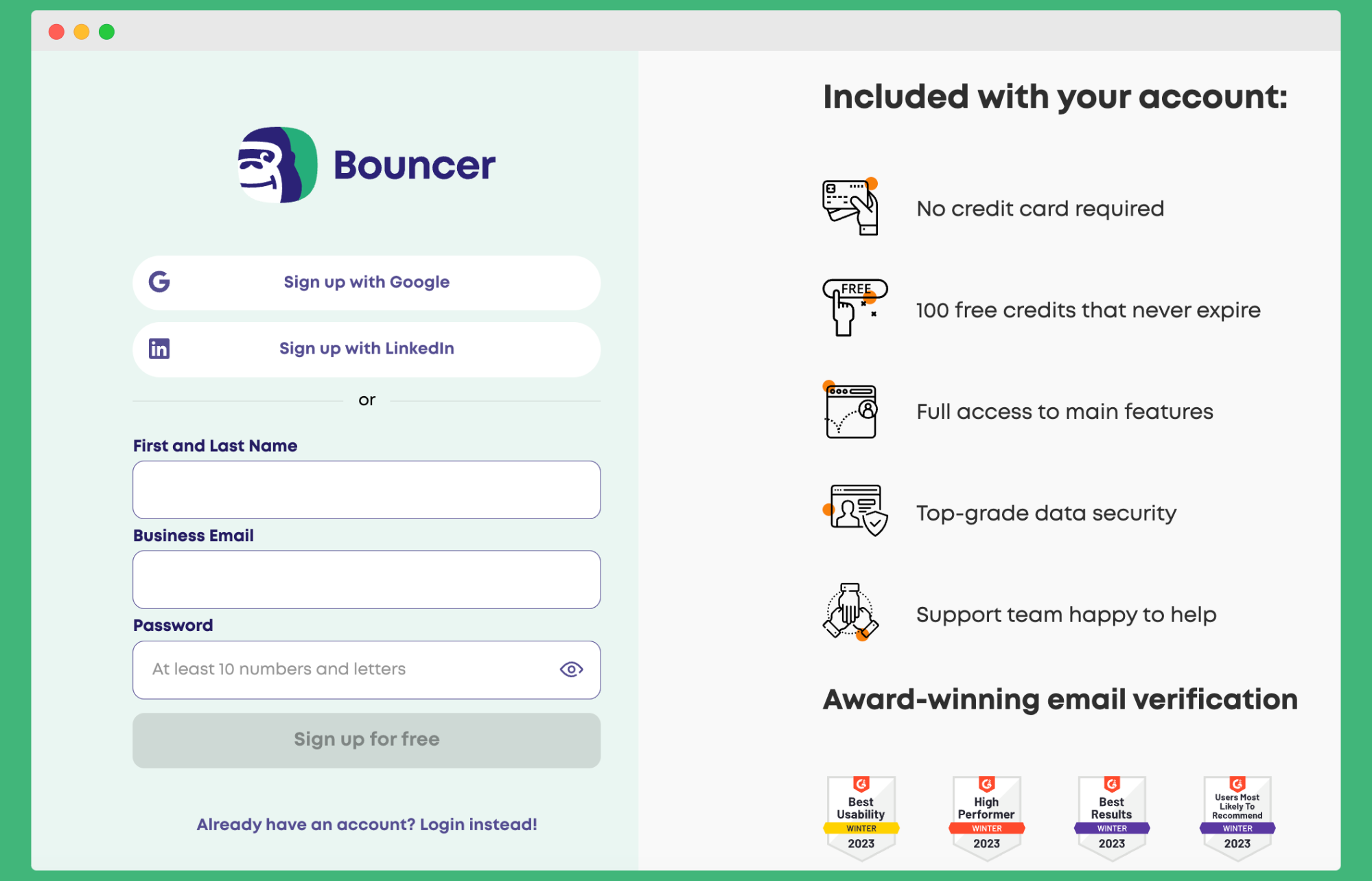
#2 Zerobounce
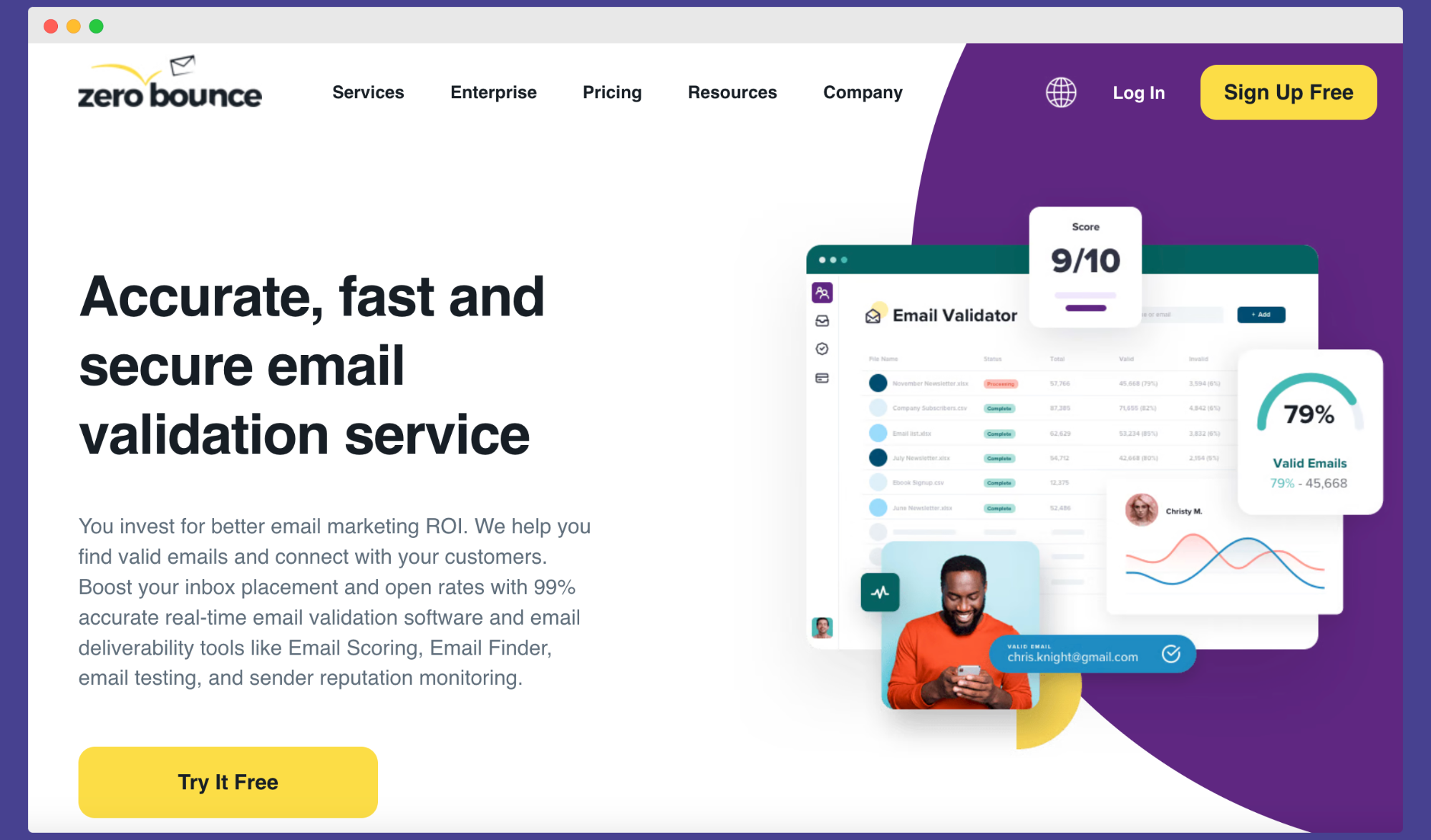
ZeroBounce is an email verification and list cleaning service that helps businesses maintain accurate and up-to-date email lists. Its main job is to find incorrect, spam-trap, disposable, abusive, and invalid email addresses so that marketing campaigns reach real inboxes.
What sets ZeroBounce apart is its claimed 99% accuracy rate, real-time API for seamless integration, and additional features like email scoring, detailed reporting, inbox placement testing, and spam checker. ZeroBounce works best for email marketers, sales teams, and companies that rely on email outreach a lot.
#3 Driftrock
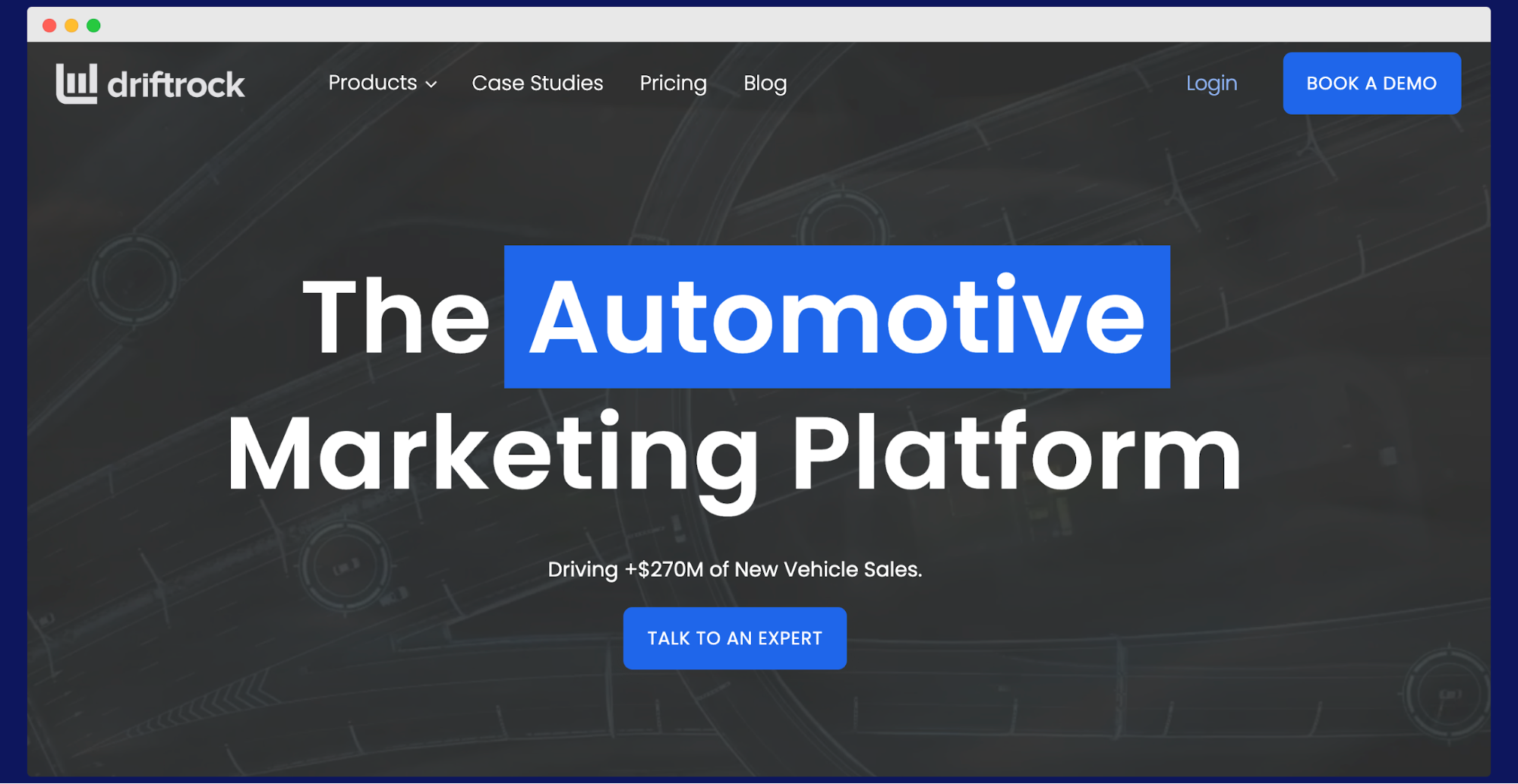
Driftrock’s lead verification capabilities are an integral part of its lead generation and management platform.
As leads are captured from various sources like website forms and ad campaigns, Driftrock validates the accuracy of the provided contact information.
Each lead is given a “validation status,” which makes it easy for businesses to spot and stop entries that are not valid from going to their CRM or marketing automation systems.
Driftrock’s detailed reporting on the sources of invalid leads helps improve efforts to get new leads. Its lead verification feature lets companies focus their marketing and sales efforts on real prospects, which boosts productivity and makes the most of the ROI of lead generation campaigns.
#4 Growform
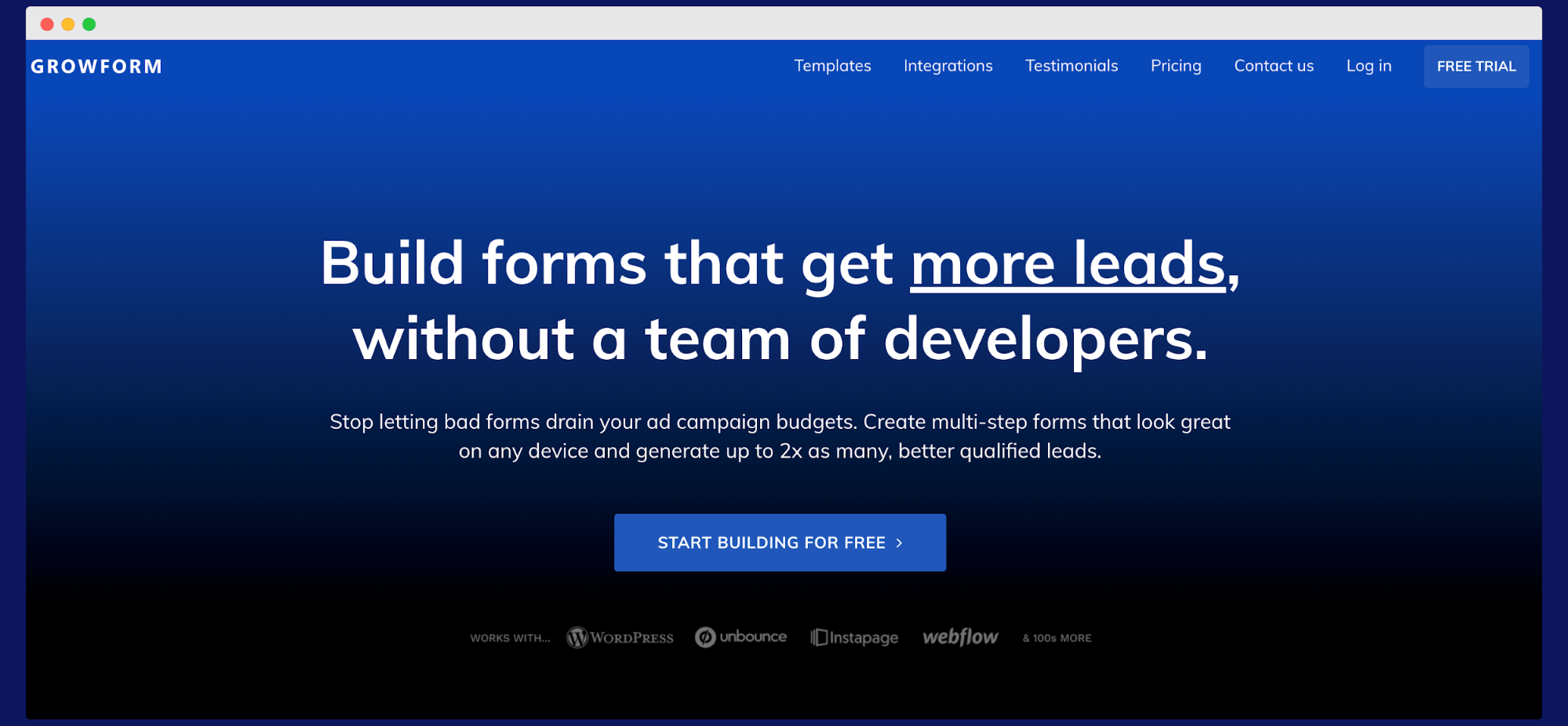
Growform is a multi-step form builder designed to boost lead generation and conversion rates. Its key features include conditional logic for personalized questions, integration with CRM and marketing tools via Zapier, custom CSS and JavaScript capabilities, and pre-built templates for various industries.
While it offers these advanced features to create engaging user experiences, Growform’s standout capability is its lead verification functionality. It allows businesses to validate the accuracy of lead data, including email addresses, phone numbers, and physical addresses, in real time as leads are captured through the forms.
Growform’s lead verification is particularly valuable for industries like B2B/SaaS, real estate, and insurance, where lead quality is crucial.
Enhancing Sales and Marketing Efforts with Lead Verification Tools
In the realm of sales and marketing, ensuring the quality of your leads is crucial for effective campaigns and high conversion rates. A robust lead verification tool can streamline your lead verification process, enhancing the efficiency of your sales and marketing efforts. Here’s how leveraging these tools can benefit your business.
Key Features of Lead Verification Tools
-
Lead Validation Lead validation is essential for maintaining a high lead quality. A reliable tool can help you verify leads by checking the authenticity of their contact details and eliminating unverified leads from your database.
-
Real-Time Verification Utilizing real time verification ensures that your leads are validated as they come in, keeping your lead database up to date. This immediate verification helps in quickly identifying fake phone numbers and temporary email addresses.
-
Comprehensive Verification Process The lead verification process involves multiple checks, including phone verification and email validation. This thorough approach ensures that you only engage with potential customers who are genuinely interested in your offerings.
Benefits of Using Lead Verification Tools
-
Improving Lead Quality By employing lead validation services, you can significantly enhance the quality of your leads. Verified leads are more likely to convert, making your sales and marketing efforts more efficient and effective.
-
Saving Time and Resources Filtering out unverified leads and temporary addresses helps in avoiding wasted time and resources. Marketing teams can focus their efforts on leads that have a higher chance of conversion, rather than chasing dead ends.
-
Enhancing Marketing Efforts Lead verification tools support your marketing efforts by providing real time API access for real time verification. This integration ensures that every lead generated through your lead form is immediately verified, maintaining the integrity of your lead data.
-
Streamlining the Lead Validation Process These tools simplify the lead validation process to just a few clicks. This ease of use allows marketing teams to quickly validate leads without extensive manual effort, ensuring that their databases are always accurate and up to date.
Practical Applications
-
Lead Generation and Verification During lead generation, it’s crucial to validate leads to ensure they are genuine. Lead verification services help in verifying contact details and removing temporary email addresses and fake phone numbers from your list.
-
Maintaining Accurate Lead Databases Regular use of a lead verification tool ensures that your lead database remains accurate. This accuracy is essential for effective sales and marketing strategies, as it prevents wasted time on invalid leads.
-
Enhancing Customer Interaction Verified leads enable more meaningful interactions with potential customers. Accurate data ensures that phone calls and face to face conversations are directed towards genuine prospects, increasing the likelihood of successful engagements.
By integrating a lead verification tool into your sales and marketing workflow, you can significantly improve the efficiency and effectiveness of your campaigns. These tools provide a seamless verification process, ensuring that every lead in your database is validated and ready for conversion, ultimately enhancing your overall sales and marketing efforts.
Leave bad leads in the dust
At the end of the day, a cluttered pipeline filled with invalid leads is a surefire way to waste resources and kill your sales momentum.
Don’t let junk data hold you back from closing more deals. Implementing a robust lead verification process with a powerful tool like Bouncer is the key to unlocking a high-octane sales engine fueled by genuine, validated prospects.
Bouncer’s advanced algorithms, comprehensive features, and seamless integration make it a no-brainer for businesses serious about maximizing their lead generation ROI. Stop spinning your wheels on fake leads and experience the game-changing impact of a supercharged pipeline filled with sales-ready opportunities.
Invest in lead verification with Bouncer today and leave the competition eating your dust. Grab your free trial and verify your first 100 emails completely free of charge.


